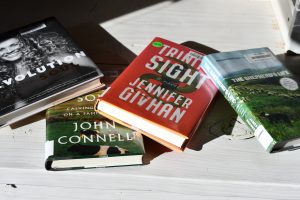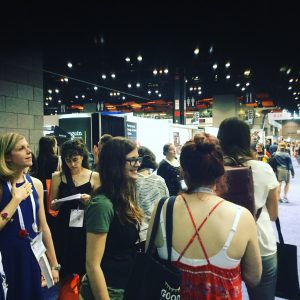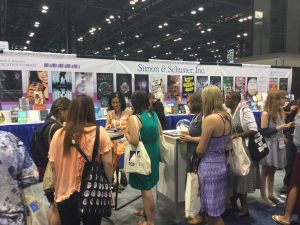- Everyone Knows Your Mother is a Witch by Rivka Galchen
- A Town Called Solace by Mary Lawson
- Pastoral Song: A Farmer’s Journey by James Rebanks
- Threading the Labyrinth by Tiffani Angus
- Dark River by Rym Kechacha
- Daughter of the Moon Goddess by Sue Lynn Tan
- Small Things Like These by Claire Keegan
- VI Warshawski books by Sara Paretsky – amazingly I’d never read any of these before!
The adventure of reading literature in translation
Anyone looking at my what I’ve been reading lately posts would probably notice: I like to read books in translation. By books in translation I mostly (but not entirely) mean, books originally published in a non-English language that I then read in English. As I’ve discussed here before, one of my all-time favorite novels is If On A Winter’s Night a Traveler, written and originally published in Italian; a sampling of other things I’ve read in the not-too-distant past that were originally published in a language other than English include Basho’s poetry, The Godmother, Baron in the Trees, Core of the Sun, and the Mirror Visitor Quartet. It’s not too hard for me to rattle off others that I love: Smilla’s Sense of Snow. The Neapolitan Novels. Momo (the book not the internet hoax). What I Talk About When I Talk About Running. I could go on and on. And that’s just the ones I remember offhand, not the ones that I enjoyed but am not remembering now, or the ones that I felt equivocal about, or even the ones I hated. I am glad I read them all, because they made my world bigger.
I will sometimes give works written in French or Spanish a read in their original language as well as in translation, but usually after having read the English version. This is partly because I’m not as fluent a reader in French and Spanish as I am in English, but it’s also because I love the insight into the art of translation. Reading the translation first and then the original not only improves my comprehension of the original, it renders me in awe of translators. Sometimes it also makes me frustrated with them, but when I read this way I am acutely aware that capturing an author’s art while getting meaning across is an impossible task (see this article for more about this!). A translation always walks a fine line between too literal and not literal enough. I find this line fascinating. I’m such a geek about this that sometimes I’ll try to read something originally published in – and which I first read in – English in its French or Spanish translation, just to see what it’s like, what new shades of meaning emerge when it’s put in another language.
(At least at this point, my reading ability in other languages isn’t good enough for me to be able to do this with works not in French or Spanish, but I keep on studying. I especially hope to add Italian to the list of languages I can read in – it’s close enough to Spanish and French that I think I should be able to get there with some concentrated study, and I am especially fond of the Italian works in translation I’ve read – but I’ve been working on German, for other reasons, recently. At some point I’d like to work on Japanese.)
Given this (admittedly peculiar) interest, and given that I travel (or used to, pre-COVID19) a lot for work, it probably won’t surprise you to hear that when I travel outside the USA I always try to spend some time browsing local bookstores. I find so many books that haven’t ever been translated into English; and at the same time, I’ve found that non-American bookstores often have an excellent stock of literature in translation (and not just translated from the English, either).
All this makes me wonder: what’s behind my difficulty in finding books in translation here at home? Are plenty of works translated, but the marketing machine for these books does not reach me, for whatever reason? Or are there in fact relatively few, and if so, does this indicate American insularity/unwillingness to buy translated works, or something more general such as the difficulty of the art of translation?
(In case you are wondering, as I was, if it is really true that books in translation aren’t as widely available in English as they are in other languages, a quick search found me a number of articles suggesting that indeed, this is the case: this article, which is about English-language translations in general, and this post, titled “Why Do Americans Read so Few Books in Translation?”, were two that I found particularly interesting. It does appear that the issue is not that I’m not able to find books that have been translated, but rather that there are relatively few non-English books that are ever translated into English.)
Works in translation are on my mind right now in part as a result of the recent passing of Carlos Ruiz Zafón, described as “the most-read Spanish author since Cervantes” in his obituary in the Guardian. I did eventually read The Shadow of the Wind in Spanish, but I started with the English translation. My life would be poorer without ever having encountered his work, or Italo Calvino’s, or Hannelore Cayre’s or Haruki Murakami‘s or Elena Ferrante‘s or Michael Ende‘s or that of so many others.
What I’ve been reading lately: searching for clarity edition
- The Baron in the Trees, by Italo Calvino
- Monday’s Not Coming, by Tiffany D. Jackson
- Old Friend from Far Away, by Natalie Goldberg
- A Memory Called Empire, by Arkady Martine
Not much to say, except doing a lot of reading (more than I’m listing here…I’ve been reading some things at the urgings of others and re-learning that I generally have pretty good instincts about what I like to read. Possibly I’ll post about that sometime) and writing (stuff that will almost certainly never see the light of day. There’s a lot of freedom in this kind of writing and I encourage everyone to give it a try). And listening. And watching. There is so much to hear, to see, to learn.
What I’ve been reading lately, turn of the year edition

This has been a cold, dark couple of weeks for me, but – despite ongoing horrible world news – I am stumbling into 2020 with what feels like cautious optimism. I hope. And the older I get, the more I realize what a gift hope is.
Here are some things I have been reading during this dark time:
- Seane Corn‘s Revolution of the Soul: part memoir, part yoga philosophy. I am impressed with Corn’s ability to tie some of these yoga philosophy concepts to real life, and with her bravery in using her own life to illustrate them.
- The Shepherd’s Life by James Rebanks. I loved this book, and will see if I can write about it in more detail later. For now: I was interested in how many things Rebanks describes about the Lake District that sound similar to New Mexico.
- The Farmer’s Son by John Connell: this was recommended as a “read-alike” to The Shepherd’s Life, but I think that’s misguided. I found it to be much more of a literary memoir than a social science one – a really good one, though, and well worth a read.
- Trinity Sight by Jennifer Givhan: the sole work of fiction on this particular list, and an example of why I want to dedicate more of my reading to small/independent press publications this year. It’s a fascinating book, complex, deep, and simultaneously a good read – and unusual enough in its conception and execution that it would be a big risk for a major publisher. I really enjoyed it and am looking forward to re-reading it.
Into the new: reflecting on reading and writing in 2019

December is, for me, the season of reflection. For the past week or two, as things have wound down at work, in the garden, everywhere, I’ve been thinking about reading and writing – what I’ve been doing over the past year, and what I’d like to change.
I didn’t get as much writing done in 2019 as I had hoped I would; there’s nothing new in that (does anyone ever get as much writing done as they had hoped?). I *did* have breakthroughs with a couple of different projects that were stalled at this point last year, and I know how I want to proceed with them now. The trouble is that I have too many concurrent projects going, and it’s not yet clear to me which of these I will pursue first and which will wait. This decision is at the forefront of my reflections right now. I will decide this, sometime over the next few weeks, and we will see.
On the positive progress side of things, I was able to return to reading in 2019. I read lots, and I wrote about reading, too (here and here and here and here and here and here and here and here and here and here and here). I’m happy about this – both the reading and the writing about it. My reflective reading brain is slowly creaking to life again, it seems. I am so glad to have it back.
And yet, despite this, I’ve been frustrated by my reading lately. This has happened before (and it’s a not-uncommon experience), but, this year (and maybe in previous years also, I don’t know) and for me, I think my frustration isn’t a purely internal phenomenon. I think it has to do with what’s being published, at least in part (this and this and this contain some previous related reflections).
When I’ve felt this in previous reading slumps, I’ve pushed back against my instincts, telling myself it’s all internal. And maybe I was right; I did manage to get out of those previous reading slumps. But this time, I’m going to try something new to address this. Following up on some recent thoughts on self-publishing/small presses, I’m going to try to devote a majority percentage of my 2020 reading to works published by small and independent publishers, rather than by the big 5.
I’m still working out how I will actualize this, but I’ll write about it here as I figure it out.
Some thoughts on the Wayfarers series

I recently read/re-read the three books in Becky Chambers’ Wayfarers series: The Long Way to a Small Angry Planet, A Closed and Common Orbit, and Record of a Spaceborn Few. I’ve loved these books since I read the first one, and even though they are relatively recent (in the case of the last, quite recent, only a year old), they have swiftly made their way onto my shelf of comfort re-reads. (If you are deducing from this paragraph that I’ve recently been in need of comfort, well, you aren’t wrong.)
For anyone who hasn’t read them, the Wayfarers books take place in a future in which humans have destroyed earth and moved off-planet, where they have encountered other species who have banded together to create a “Galactic Commons” government. In the Wayfarers world, humans were relatively recently granted Galactic Commons (GC) membership and are lower-status members of the galaxy.
These books have been quite successful. The first, The Long Way to a Small Angry Planet, began life as a Kickstarter-funded self-publishing project; it went on to be nominated for the 2015 Kitschies (Best Debut) and was subsequently picked up and republished by Hodder & Stoughton and, in the US, Harper Voyager. More awards nominations followed – the 2016 Grand Prix de l’Imaginaire (Best Foreign-Language Novel), 2016 Arthur C. Clarke Award, 2016 British Fantasy Awards (Best Newcomer), and 2016 Women’s Prize for Fiction – as did the following two novels (not sequels per se but rather books set in the same universe), which racked up an impressive list of awards nominations as well. The series won the 2019 Hugo Award for Best Series.
The thing about the Wayfarers series, for me, is that none of the books are strongly plot-driven. A Closed and Common Orbit is a bit more so than the other two; the Long Way to a Small Angry Planet is like a character-driven science fiction television series (I will not be the first to note that it has a similar feel to Firefly, although Chambers’ Galactic Commons is quite different than the universe inhabited by the ship Serenity) while Record of a Spaceborn Few reads like an engagingly-written piece of ethnography. The world-building and the characters are what make these novels so fun to read, not the plot. They are also unfailingly optimistic, and given the current state of the world, who couldn’t use a little optimism? But the character- and world-driven nature of these books is startlingly unusual in the recently published books I’ve come across. I’m amazed that they were published by big publishing houses – tremendously grateful, for chances are I would never have found them otherwise, but amazed nonetheless. I’d have guessed that their non-plot-driven aspects would have immediately flagged them as no-go for major publishing houses. And I suppose I wouldn’t have been wrong to make such a guess, as it’s only after the success of The Long Way to a Small Angry Planet as a self-published work that they got picked up.
In this sense, the Wayfarers books are not dissimilar to Check, Please! Both are optimistic as well as episodic rather than plot-driven; both were self-published, gained success, and were subsequently picked up by major publishers. Obviously they are substantively different in other ways – but to me, both reflect how self-publishing has been changing norms about what types of books will be successful. I can’t help but hope their publication signals a shift among traditional publishers, an increased willingness to take a chance, to move away from marketing-defined pigeonholes and to publish some works that have unusual and perhaps risky characteristics and yet are nonetheless truly quality.
I am probably hoping too much. But my experience with Wayfarers, and with Check, Please! too, highlights a reason why I am hoping this: if these works had not been picked up by major publishers, I almost certainly would not have encountered them. Self-published and small press-published works are difficult to find if what you are looking for is quality rather than something that falls squarely in a genre; there are so many of them, and they are so all over the map in terms of their execution. I was lucky enough to find Younger-Older Ones and Tales from Rugosa Coven on my own. How many similarly quality books have I missed, all the while bemoaning the lack of innovation among recent traditionally published books? And yet, the pool of self-published and small press-published books is so very large as to make the task of sorting through it nearly impossible.
Chambers has a new standalone novella out this fall. I haven’t read it yet, but I look forward to it.
Usual disclaimer: while some of the links above will take you to Amazon, they are for informational purposes only. The links should not be taken as any kind of recommendation to buy the product from the linked source, and neither I nor this site receive any funds from links to commercial sources.
Sirens 2019 Reading Challenge reading update
I’ve been relatively slow in my reading this winter; too much else going on. Here’s where I currently stand on the 2019 Sirens Reading Challenge:
Guests of Honor (two more to go)
- Borderline by Mishell Baker
- Aru Shah and the End of Time by Roshani Chokshi
- The Bloodprint by Ausma Zehanat Khan
Heroes Books – Required (category complete!)
- Wake of Vultures by Lila Bowen
- The One Hundred Nights of Hero by Isabel Greenberg
- Dread Nation by Justina Ireland
- Where the Mountain Meets the Moon by Grace Lin
- The Tiger’s Daughter by K Arsenault Rivera
Heroes Books – Pick Five (four to go)
- The Book of Joan by Lidia Yuknavitch
Middle Grade/Young Adult Books – Pick Five (not started)
Adult – Pick Five (not started)
Previous posts on what I’ve been reading for the 2019 Sirens Reading Challenge are here, here and here. I also participated in the 2017 Sirens Reading Challenge.
The ALA 2017 exhibits experience and THE GLASS SENTENCE
Every few years, I get to attend the American Libraries Association (ALA) conference, courtesy of my partner (who is a librarian). I tag along to whatever cool location in which the meeting is being held and get an exhibits-only pass. Why bother getting a pass? One simple reason: ALA exhibits are *awesome*.
They have robots. Author talks. Publisher displays, from publishers large and small, with recently published and forthcoming books. Sometimes they give some of those books away. In fact for me the most difficult aspect of going to ALA exhibits, aside from the general overstimulating nature of it all, is not picking up too many books.

(There are lots of other things in the ALA exhibits as well as books and book-related booths, like displays on library automation software and databases. I like those too.)
This year ALA was in Chicago. Not only did I wind up with a number of exciting-looking books (most of which I knew nothing about prior to the conference)…
I watched a cooking demo by Joshua McFadden…

I got an advance copy of Jane Unlimited by Kristin Cashore…

and I met up with the fantastic Cindy Pon!

To top that all off I spent some time exploring Chicago, including eating pierogis at Tryzub, a Ukranian restaurant; experiencing the Purple Pig; and exploring Read It & Eat, a cookbook-focused bookstore.
Yes, I spent all my time reading, eating, and talking with other people about reading and eating. And if that doesn’t sound totally worth the price of admission to you, well, probably you don’t read this blog.
(I did also attend the Chicago – Orlando MLS game, but I ate and drank while there so technically this is in the “eating” category. I didn’t read at the game, but it was still super-fun.)
In the midst of all this activity I also finished The Glass Sentence by S.E. Grove, a book I’ve been meaning to read since it came out. I definitely enjoyed it – it has great world-building and does interesting things with the concept of time. As this review points out it’s in the tradition of Philip Pullman‘s His Dark Materials trilogy, but (maybe because of the American setting) to me it had a very different feel. I’m still mulling over my reaction beyond “I liked it,” though. I suspect I won’t really know until I’ve read the other two in the series.
However, those other two books will have to wait, much as I enjoyed The Glass Sentence. My reading for the next few weeks will focus on the Advance Reader Copies/other books I picked up at ALA, so stay tuned for some thoughts on those!
